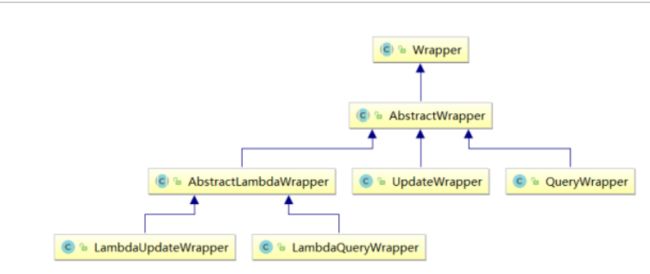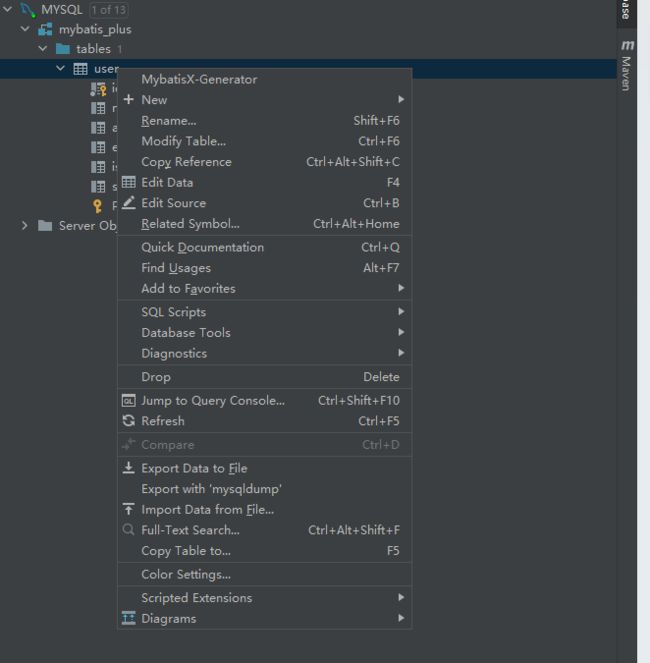Mybatis-Plus快速入门及使用(超详细+干货满满)
特性:
- 无侵入:只做增强不做改变,不会对现有的工程产生影响
- 损耗小:启动即会自动注入基本CRUD,直接面向对象操作
- 强大的CRUD操作:内置通用Mapper、通用Service,通过少量配置即可实现单表大部分CRUD操作,更有强大的条件构造器,满足各类使用需求。
- 支持Lambda形式调用:通过Lambda表达式,方便的编写各类查询条件,无需担心字段写错。
- 支持主键自动生成:支持多达4种主键策略(内含分布式唯一ID生成器 - Sequence),可自由配置,完美解决主键问题。
- 支持ActiveRecord模式:支持ActiveRecord形式调用,实体类只需要继承Model类即可进行强大的CRUD操作。
- 内置代码生成器:采用代码或者Maven插件可以快速生成Mapper、Model、Service、Controller层代码,支持模板引擎。
- 内置分页插件:基于Mybatis物理分页,开发者无需关心具体操作,配置好插件之后,写分页等同于普通List查询
-
创建Mybatis-plus工程需要引入的依赖
org.springframework.boot
spring-boot-starter
org.springframework.boot
spring-boot-starter-test
test
com.baomidou
mybatis-plus-boot-starter
3.5.1
org.projectlombok
lombok
true
com.mysql
mysql-connector-j
- Mybatis-plus配置文件
spring:
#配置数据源信息
datasource:
type: com.zaxxer.hikari.HikariDataSource
#配置数据库连接信息
driver-class-name: com.mysql.cj.jdbc.Driver
url: jdbc:mysql://localhost
username: root
password: root
#mybatisplus添加日志功能
mybatis-plus:
configuration:
log-impl: org.apache.ibatis.logging.stdout.stdOutImpl
global-config:
db-config:
#配置Mybatis-plus操作表的默认前缀
table-prefix: t_
#配置Mybatis-plus的主键策略
id-type: auto配置文件注意事项
1、驱动类driver-class-name
spring boot 2.0(内置jdbc5驱动),驱动类使用:driver-class-name: com.mysql.jdbc.Driver
spring boot 2.1及以上(内置jdbc8驱动),驱动类使用:
driver-class-name: com.mysql.cj.jdbc.Driver
否则运行测试用例的时候会有 WARN 信息
2、连接地址url
MySQL5.7版本的url:
jdbc:mysql://localhost:3306/?characterEncoding=utf-8&useSSL=false
MySQL8.0版本的url:
jdbc:mysql://localhost:3306/?
serverTimezone=GMT%2B8&characterEncoding=utf-8&useSSL=false
否则运行测试用例报告如下错误:
java.sql.SQLException: The server time zone value 'Öйú±ê׼ʱ¼ä' is unrecognized or represents more
// 这个属性用于指定 MyBatis Mapper XML 文件的位置,例如:mybatis-plus: mapper-locations: classpath*:/mapper/*Mapper.xml
mybatis-plus.mapper-locations
// 这个属性用于设置是否显示 MyBatis-Plus 的启动 banner。在示例中,该属性被设置为 false,表示禁用启动 banner
mybatis-plus.global-config.banner
// 这个属性用于设置主键 ID 的生成策略。在示例中,auto 表示使用数据库自动生成的主键 ID
mybatis-plus.global-config.db-config.id-type:auto
// 这些属性用于设置全局的 SQL 过滤策略。在示例中,not_empty 表示只在参数值非空时才会生成对应的 SQL 条件
mybatis-plus.global-config.db-config.where-strategy:not_empty
mybatis-plus.global-config.db-config.insert-strategy:not_empty
mybatis-plus.global-config.db-config.update-strategy:not_null
// 这个属性用于设置在 SQL 中处理空值时使用的 JDBC 类型。在示例中,'null' 表示使用 NULL 类型
mybatis-plus.configuration.jdbc-type-for-null:'null'
// 这个属性用于设置是否在设置属性为 NULL 时调用对应的 setter 方法。在示例中,该属性被设置为 true,表示在设置属性为 NULL 时会调用 setter 方法
mybatis-plus.configuration.call-setters-on-nulls:true-
Mybatis-plus启动类配置
在Spring Boot启动类中添加@MapperScan注解,扫描mapper包
@SpringBootAoolication
@MapperScan("")
public class MybatisplusApplication {
public static void main(String[] args) {
SpringApplication.run(MybatisplusApplication.class, args);
}
}-
Mybatis-plus基本CRUD代码
@Data //lombok注解
public class User {
private Long id;
private String name;
private Integer age;
private String email;
}@Test
public void testInsert(){
User user = new User(null, "张三", 23, "[email protected]");
//INSERT INTO user ( id, name, age, email ) VALUES ( ?, ?, ?, ? )
int result = userMapper.insert(user);
System.out.println("受影响行数:"+result);
//1475754982694199298
System.out.println("id自动获取:"+user.getId());
}//通过id删除记录
@Test
public void testDeleteById(){
//通过id删除用户信息
//DELETE FROM user WHERE id=?
int result = userMapper.deleteById(1475754982694199298L);
System.out.println("受影响行数:"+result);
}
//通过id批量删除记录
@Test
public void testDeleteBatchIds(){
//通过多个id批量删除
//DELETE FROM user WHERE id IN ( ? , ? , ? )
List idList = Arrays.asList(1L, 2L, 3L);
int result = userMapper.deleteBatchIds(idList);
System.out.println("受影响行数:"+result);
}
//通过map条件删除记录
@Test
public void testDeleteByMap(){
//根据map集合中所设置的条件删除记录
//DELETE FROM user WHERE name = ? AND age = ?
Map map = new HashMap<>();
map.put("age", 23);
map.put("name", "张三");
int result = userMapper.deleteByMap(map);
System.out.println("受影响行数:"+result);
} @Test
public void testUpdateById(){
User user = new User(4L, "admin", 22, null);
//UPDATE user SET name=?, age=? WHERE id=?
int result = userMapper.updateById(user);
System.out.println("受影响行数:"+result);
}//根据id查询用户信息
@Test
public void testSelectById(){
//根据id查询用户信息
//SELECT id,name,age,email FROM user WHERE id=?
User user = userMapper.selectById(4L);
System.out.println(user);
}
//根据多个id查询多个用户信息
@Test
public void testSelectBatchIds(){
//根据多个id查询多个用户信息
//SELECT id,name,age,email FROM user WHERE id IN ( ? , ? )
List idList = Arrays.asList(4L, 5L);
List list = userMapper.selectBatchIds(idList);
list.forEach(System.out::println);
}
//根据map条件查询用户信息
@Test
public void testSelectByMap(){
//通过map条件查询用户信息
//SELECT id,name,age,email FROM user WHERE name = ? AND age = ?
Map map = new HashMap<>();
map.put("age", 22);
map.put("name", "admin");
List list = userMapper.selectByMap(map);
list.forEach(System.out::println);
}
//查询所有数据
@Test
public void testSelectList(){
//查询所有用户信息
//SELECT id,name,age,email FROM user
List list = userMapper.selectList(null);
list.forEach(System.out::println);
} Map层
BaseMapper是MyBatis-Plus提供的模板mapper,其中包含了基本的CRUD方法,泛型为操作的实体类型
public interface UserMapper extends BaseMapper {
} Service服务层
通用 Service CRUD 封装IService接口,进一步封装 CRUD 采用 get 查询单行 ,remove 删除 ,list 查询集合 ,page 分页 ,前缀命名方式区分 Mapper 层避免混淆。
泛型 T 为任意实体对象
/**
* UserService继承IService模板提供的基础功能
*/
public interface UserService extends IService {
}
/**
* ServiceImpl实现了IService,提供了IService中基础功能的实现
* 若ServiceImpl无法满足业务需求,则可以使用自定的UserService定义方法,并在实现类中实现
*/
@Service
public class UserServiceImpl extends ServiceImpl implements
UserService {
} //测试查询记录数
@Autowired
private UserService userService;
@Test
public void testGetCount(){
long count = userService.count();
System.out.println("总记录数:" + count);
}
//测试批量插入
@Test
public void testSaveBatch(){
// SQL长度有限制,海量数据插入单条SQL无法实行,
// 因此MP将批量插入放在了通用Service中实现,而不是通用Mapper
ArrayList users = new ArrayList<>();
for (int i = 0; i < 5; i++) {
User user = new User();
user.setName("ybc" + i);
user.setAge(20 + i);
users.add(user);
}
//SQL:INSERT INTO t_user ( username, age ) VALUES ( ?, ? )
userService.saveBatch(users);
} Mybatis-plus搭配常用注解
@TableName : 在实体类类型上添加@TableName("t_user"),标识实体类对应的表,即可成功执行SQL语句,使操作数据库的表名和实体类型的类名一致。
@TableName("t_user")
public class User{
private Long id;
private String name;
}
//t_user是数据库的表名,User是类名@TableId : 作用是将其标识为主键
@TableId的value属性:
若实体类中主键对应的属性为id,而表中表示主键的字段为uid,此时若只在属性id上添加注解 @TableId,则抛出异常Unknown column 'id' in 'field list',即MyBatis-Plus仍然会将id作为表的主键操作,而表中表示主键的是字段uid 此时需要通过@TableId注解的value属性,指定表中的主键字段,@TableId("uid")或 @TableId(value="uid")
@TableId的type属性:type属性用来定义主键策略
常见的主键策略:
IdType.ASSIGN_ID(默认):基于雪花算法的策略生成数据id,与数据库id是否设置自增无关。
IdType.AUTO :使用数据库的自增策略,注意,该类型请确保数据库设置了id自增, 否则无效。
@TableField
例如实体类属性name,表中字段username,此时需要在实体类属性上使用@TableField("username")设置属性所对应的字段名
public class User{
private Long id;
@TableField("username")
private String name;
private Integer age;
private String email;
}@TableLogic:表示为逻辑删除
物理删除:真实删除,将对应数据从数据库中删除,之后查询不到此条被删除的数据。
逻辑删除:假删除,将对应数据中代表是否被删除字段的状态修改为“被删除状态”,之后在数据库 中仍旧能看到此条数据记录。
使用场景:可以进行数据恢复
public class User{
private Long id;
@TableField("username")
private String name;
private Integer age;
private String email;
@TableLogic
private Integer isDeleted;
}测试:测试删除功能,真正执行的是修改: UPDATE t_user SET is_deleted=1 WHERE id=? AND is_deleted=0
测试查询功能,被逻辑删除的数据默认不会被查询 :SELECT id,username AS name,age,email,is_deleted FROM t_user WHERE is_deleted=0
条件构造器和常用接口
wapper : 条件构造抽象类,最顶端父类
AbstractWrapper:用于查询条件封装,生成sql的where条件
QueryWrapper:查询条件封装
UpdateWrapper:Update条件封装
AbstractLambdaWrapper:使用Lambda语法
LambdaQueryWrapper: 用于Lambda语法使用的查询Wrapper
LambdaUpdateWrapper: Lambda更新封装Wrapper
//组装查询条件
@Test
public void test01(){
//查询用户名包含a,年龄在20到30之间,并且邮箱不为null的用户信息
QueryWrapper queryWrapper = new QueryWrapper<>();
queryWrapper.like("name","a")
.between("age",20,30)
.isNotNull("email");
List list = userMapper.selectList(queryWrapper);
list.forEach(System.out::println);
}
//组装排序条件
@Test
public void test02(){
//按年龄降序查询用户,如果年龄相同则按id升序排列
//SELECT id,username AS name,age,email,is_deleted FROM t_user WHERE is_deleted=0 ORDER BY age DESC,id ASC
QueryWrapper queryWrapper = new QueryWrapper<>();
queryWrapper
.orderByDesc("age")
.orderByAsc("id");
List users = userMapper.selectList(queryWrapper);
users.forEach(System.out::println);
}
//组装删除条件
@Test
public void test03(){
//删除email为空的用户
//DELETE FROM t_user WHERE (email IS NULL)
QueryWrapper queryWrapper = new QueryWrapper<>();
queryWrapper.isNull("email");
//条件构造器也可以构建删除语句的条件
int result = userMapper.delete(queryWrapper);
System.out.println("受影响的行数:" + result);
}
//条件的优先级
@Test
public void test04() {
QueryWrapper queryWrapper = new QueryWrapper<>();
//将用户名中包含有a并且(年龄大于20或邮箱为null)的用户信息修改
//UPDATE t_user SET age=?, email=? WHERE (username LIKE ? AND (age > ? OR email IS NULL))
//lambda表达式内的逻辑优先运算
queryWrapper
.like("username", "a")
.and(i -> i.gt("age", 20).or().isNull("email"));
User user = new User();
user.setAge(18);
user.setEmail("[email protected]");
int result = userMapper.update(user, queryWrapper);
System.out.println("受影响的行数:" + result);
}
//组装select子句
@Test
public void test05() {
//查询用户信息的username和age字段
//SELECT username,age FROM t_user
QueryWrapper queryWrapper = new QueryWrapper<>();
queryWrapper.select("username", "age");
//selectMaps()返回Map集合列表,通常配合select()使用,避免User对象中没有被查询到的列值为null
List> maps = userMapper.selectMaps(queryWrapper);
maps.forEach(System.out::println);
}
//实现子查询
@Test
public void test06() {
//查询id小于等于3的用户信息
//SELECT id,username AS name,age,email,is_deleted FROM t_user WHERE (id IN
(select id from t_user where id <= 3))
QueryWrapper queryWrapper = new QueryWrapper<>();
queryWrapper.inSql("id", "select id from t_user where id <= 3");
List list = userMapper.selectList(queryWrapper);
list.forEach(System.out::println);
} @Test
public void test07() {
//将(年龄大于20或邮箱为null)并且用户名中包含有a的用户信息修改
//组装set子句以及修改条件
UpdateWrapper updateWrapper = new UpdateWrapper<>();
//lambda表达式内的逻辑优先运算
updateWrapper
.set("age", 18)
.set("email", "[email protected]")
.like("username", "a")
.and(i -> i.gt("age", 20).or().isNull("email"));
//这里必须要创建User对象,否则无法应用自动填充。如果没有自动填充,可以设置为null
//UPDATE t_user SET username=?, age=?,email=? WHERE (username LIKE ? AND (age > ? OR email IS NULL))
//User user = new User();
//user.setName("张三");
//int result = userMapper.update(user, updateWrapper);
//UPDATE t_user SET age=?,email=? WHERE (username LIKE ? AND (age > ? OR email IS NULL))
int result = userMapper.update(null, updateWrapper);
System.out.println(result);
} //在真正开发的过程中,组装条件是常见的功能,而这些条件数据来源于用户输入,是可选的,因此我们在组装这些条件时,必须先判断用户是否选择了这些条件,若选择则需要组装该条件,若没有选择则一定不能组装,以免影响SQL执行的结果
@Test
public void test08UseCondition() {
//定义查询条件,有可能为null(用户未输入或未选择)
String username = null;
Integer ageBegin = 10;
Integer ageEnd = 24;
QueryWrapper queryWrapper = new QueryWrapper<>();
//StringUtils.isNotBlank()判断某字符串是否不为空且长度不为0且不由空白符(whitespace)构成
queryWrapper
.like(StringUtils.isNotBlank(username), "username", "a")
.ge(ageBegin != null, "age", ageBegin)
.le(ageEnd != null, "age", ageEnd);
//SELECT id,username AS name,age,email,is_deleted FROM t_user WHERE (age >= ? AND age <= ?)
List users = userMapper.selectList(queryWrapper);
users.forEach(System.out::println);
} @Test
public void test09() {
//定义查询条件,有可能为null(用户未输入)
String username = "a";
Integer ageBegin = 10;
Integer ageEnd = 24;
LambdaQueryWrapper queryWrapper = new LambdaQueryWrapper<>();
//避免使用字符串表示字段,防止运行时错误
queryWrapper
.like(StringUtils.isNotBlank(username), User::getName, username)
.ge(ageBegin != null, User::getAge, ageBegin)
.le(ageEnd != null, User::getAge, ageEnd);
List users = userMapper.selectList(queryWrapper);
users.forEach(System.out::println);
} @Test
public void test10() {
//组装set子句
LambdaUpdateWrapper updateWrapper = new LambdaUpdateWrapper<>();
updateWrapper
.set(User::getAge, 18)
.set(User::getEmail, "[email protected]")
.like(User::getName, "a")
.and(i -> i.lt(User::getAge, 24).or().isNull(User::getEmail)); //lambda表达式内的逻辑优先运算
User user = new User();
int result = userMapper.update(user, updateWrapper);
System.out.println("受影响的行数:" + result);
} StringUtils.isNotBlank()判断某字符串是否不为空且长度不为0且不由空白符(whitespace)构成MybatisPlus插件
MybatisPlus自带分页插件,只要简单的配置既可实现分页功能
@Configuration
@MapperScan("com.atguigu.mybatisplus.mapper") //可以将主类中的注解移到此处
public class MybatisPlusConfig {
@Bean
public MybatisPlusInterceptor mybatisPlusInterceptor() {
MybatisPlusInterceptor interceptor = new MybatisPlusInterceptor();
interceptor.addInnerInterceptor(new PaginationInnerInterceptor(DbType.MYSQL));
return interceptor;
}
}@Test
public void testPage(){
//设置分页参数
Page page = new Page<>(1, 5);
userMapper.selectPage(page, null);
//获取分页数据
List list = page.getRecords();
list.forEach(System.out::println);
System.out.println("当前页:"+page.getCurrent());
System.out.println("每页显示的条数:"+page.getSize());
System.out.println("总记录数:"+page.getTotal());
System.out.println("总页数:"+page.getPages());
System.out.println("是否有上一页:"+page.hasPrevious());
System.out.println("是否有下一页:"+page.hasNext());
}
测试结果:
User(id=1, name=Jone, age=18, [email protected], isDeleted=0) User(id=2,
name=Jack, age=20, [email protected], isDeleted=0) User(id=3, name=Tom,
age=28, [email protected], isDeleted=0) User(id=4, name=Sandy, age=21,
[email protected], isDeleted=0) User(id=5, name=Billie, age=24, email=test5@ba
omidou.com, isDeleted=0) 当前页:1 每页显示的条数:5 总记录数:17 总页数:4 是否有上一
页:false 是否有下一页:true 通用枚举
package com.atguigu.mp.enums;
import com.baomidou.mybatisplus.annotation.EnumValue;
import lombok.Getter;
@Getter
public enum SexEnum {
MALE(1, "男"),
FEMALE(2, "女");
@EnumValue
private Integer sex;
private String sexName;
SexEnum(Integer sex, String sexName) {
this.sex = sex;
this.sexName = sexName;
}
}mybatis-plus:
configuration:
# 配置MyBatis日志
log-impl: org.apache.ibatis.logging.stdout.StdOutImpl
global-config:
db-config:
# 配置MyBatis-Plus操作表的默认前缀
table-prefix: t_
# 配置MyBatis-Plus的主键策略
id-type: auto
# 配置扫描通用枚举
type-enums-package: com.atguigu.mybatisplus.enums@Test
public void testSexEnum(){
User user = new User();
user.setName("Enum");
user.setAge(20);
//设置性别信息为枚举项,会将@EnumValue注解所标识的属性值存储到数据库
user.setSex(SexEnum.MALE);
//INSERT INTO t_user ( username, age, sex ) VALUES ( ?, ?, ? )
//Parameters: Enum(String), 20(Integer), 1(Integer)
userMapper.insert(user);
} @EnumValue:设置性别信息为枚举项,会将@EnumValue注解所标识的属性值存储到数据库代码生成器
com.baomidou
mybatis-plus-generator
3.5.1
org.freemarker
freemarker
2.3.31
public class FastAutoGeneratorTest {
public static void main(String[] args) {
FastAutoGenerator.create()
.globalConfig(builder -> {
builder.author("atguigu") // 设置作者
//.enableSwagger() // 开启 swagger 模式
.fileOverride() // 覆盖已生成文件
.outputDir("D://mybatis_plus"); // 指定输出目录
})
.packageConfig(builder -> {
builder.parent("com.atguigu") // 设置父包名
.moduleName("mybatisplus") // 设置父包模块名
.pathInfo(Collections.singletonMap(OutputFile.mapperXml, "D://mybatis_plus"));
// 设置mapperXml生成路径
})
.strategyConfig(builder -> {
builder.addInclude("t_user") // 设置需要生成的表名
.addTablePrefix("t_", "c_"); // 设置过滤表前缀
})
.templateEngine(new FreemarkerTemplateEngine()) // 使用Freemarker引擎模板,默认的是Velocity引擎模板
.execute();
}
}多数据源
适用于多种场景:纯粹多库、 读写分离、 一主多从、 混合模式。
目前我们就来模拟一个纯粹多库的一个场景,其他场景类似
场景说明:
我们创建两个库,分别为:mybatis_plus(以前的库不动)与mybatis_plus_1(新建),将
mybatis_plus库的product表移动到mybatis_plus_1库,这样每个库一张表,通过一个测试用例
分别获取用户数据与商品数据,如果获取到说明多库模拟成功
//创建数据库mybatis_plus_1和表product
CREATE DATABASE `mybatis_plus_1` /*!40100 DEFAULT CHARACTER SET utf8mb4 */;
use `mybatis_plus_1`;
CREATE TABLE product
(
id BIGINT(20) NOT NULL COMMENT '主键ID',
name VARCHAR(30) NULL DEFAULT NULL COMMENT '商品名称',
price INT(11) DEFAULT 0 COMMENT '价格',
version INT(11) DEFAULT 0 COMMENT '乐观锁版本号',
PRIMARY KEY (id)
);
//添加测试数据
INSERT INTO product (id, NAME, price) VALUES (1, '外星人笔记本', 100);
//删除mybatis_plus库product表
use mybatis_plus;
DROP TABLE IF EXISTS product;<
com.baomidou
dynamic-datasource-spring-boot-starter
3.3.2
spring:
# 配置数据源信息
datasource:
dynamic:
# 设置默认的数据源或者数据源组,默认值即为master
primary: master
# 严格匹配数据源,默认false.true未匹配到指定数据源时抛异常,false使用默认数据源
strict: false
datasource:
master:
url: jdbc:mysql://localhost:3306/
driver-class-name: com.mysql.cj.jdbc.Driver
username: root
password: root
slave_1:
url: jdbc:mysql://localhost:3306/
driver-class-name: com.mysql.cj.jdbc.Driver
username: root
password: rootpublic interface UserService extends IService {}
@DS("master") //指定所操作的数据源
@Service
public class UserServiceImpl extends ServiceImpl implements UserService {
} public interface ProductService extends IService {}
@DS("slave_1")
@Service
public class ProductServiceImpl extends ServiceImpl implements ProductService {
} @Autowired
private UserService userService;
@Autowired
private ProductService productService;
@Test
public void testDynamicDataSource(){
System.out.println(userService.getById(1L));
System.out.println(productService.getById(1L));
}@DS("") - 指定所操作的数据源 "里面填写的是数据源的名字"MybatisX插件
MyBatis-Plus为我们提供了强大的mapper和service模板,能够大大的提高开发效率
但是在真正开发过程中,MyBatis-Plus并不能为我们解决所有问题,例如一些复杂的SQL,多表
联查,我们就需要自己去编写代码和SQL语句,我们该如何快速的解决这个问题呢,这个时候可
以使用MyBatisX插件
MyBatisX一款基于 IDEA 的快速开发插件,为效率而生,MyBatisX插件用法:https://baomidou.com/pages/ba5b24/
步骤:
com.baomidou
mybatis-plus-boot-starter
3.5.1
org.projectlombok
lombok
true
com.mysql
mysql-connector-j
com.baomidou
mybatis-plus-generator
3.5.1
org.freemarker
freemarker
2.3.31
- 点击IDEA自带的database,通过data source and Drivers进行数据库连接
选择需要生成MybatisX插件的数据库表,点击MybatisX-Generator生成器
- 进行配置Generate Options,选择mybatis-plus3,点击Finish即可生成成功。



